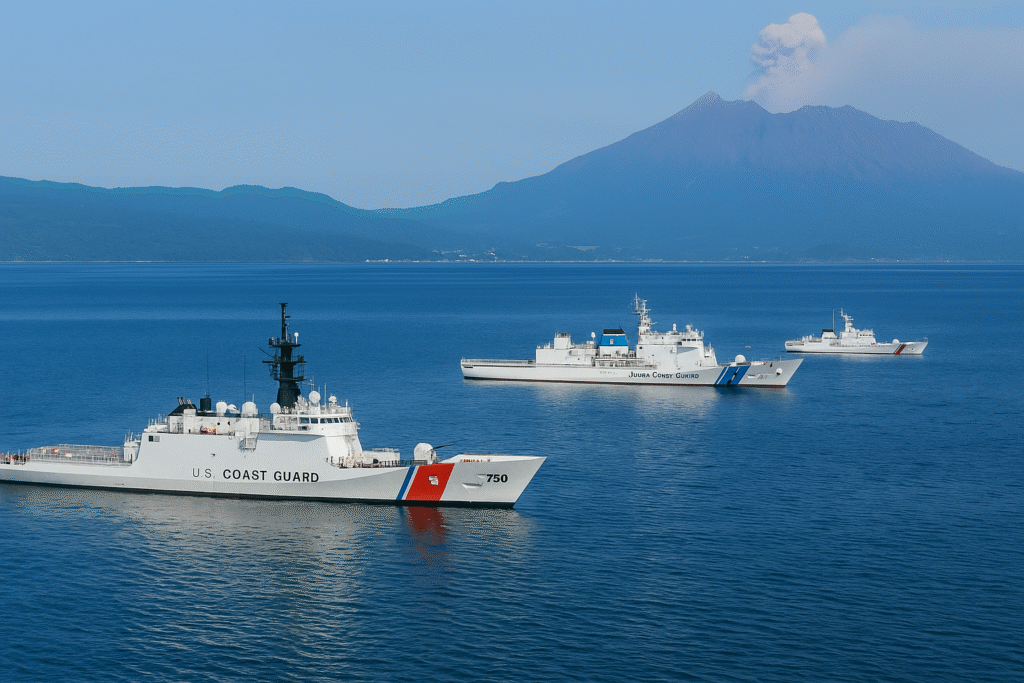
“Rising frictions between China and other nations asserting claims over territories in the East and South China Seas have compelled Japan to strengthen its bonds with the Philippines and the United States.”
Helicopters roared above the slopes of a smouldering volcano, while boats glided across the sea to retrieve life-like training dummies, in a grand display of maritime cooperation between Japan, the United States, and the Philippines this week.
Helicopters roared above the slopes of a smouldering volcano, while boats glided across the sea to retrieve life-like training dummies, in a grand display of maritime cooperation between Japan, the United States, and the Philippines this week.
The joint coast guard maneuvers, conducted off the southwestern shores of Japan, came in the wake of a united cautionary statement issued by the three nations, expressing concern over Chinese activities in contested maritime regions.
Rising tensions in the East and South China Seas, where overlapping territorial claims persist, have prompted Japan to fortify its maritime partnerships with both the United States and the Philippines.
This week’s exercises marked the second occurrence of joint coast guard training among the trio, and notably, the first to be held on Japanese waters.
The drills were conducted over a span of five days near Kagoshima, beneath the looming presence of Sakurajima volcano, which quietly emitted smoke and ash into the sky.
Numerous personnel from each nation’s coast guard participated in the exercises. The final day, Friday, featured one vessel from each country, including the BRP Teresa Magbanua, a Philippine ship provided by Japan under a loan agreement.
This 2,265-ton vessel—named in honor of a revered educator and revolutionary—is primarily tasked with monitoring Chinese maritime movements in the South China Sea.
For months, the Philippines and China have found themselves locked in a series of confrontations over disputed waters—territory which Beijing claims almost in entirety, in defiance of a landmark international ruling that invalidated such claims.
Meanwhile, Chinese and Japanese patrol vessels continue to engage in tense maritime encounters in the East China Sea, especially around contested islets.
On Friday, the Philippines formally accused China of deploying a water cannon against two of its Bureau of Fisheries vessels that were attempting to deliver provisions to Filipino fishermen operating near the Scarborough Shoal.
Man Overboard Drill
The United States was represented by the USCGC Stratton, a cutter capable of carrying up to 170 crew members, while Japan deployed the 6,000-ton Asanagi.
Friday’s operations commenced with a “man overboard” simulation. A bright-red dummy was cast into the sea, prompting a drone launch from the Stratton, which ascended and scanned the waters below.
A swift Philippine rescue craft emerged from the Teresa Magbanua, racing toward the location. Coast guard officers promptly retrieved the dummy from the sea.
Other rescue scenarios included a Japanese helicopter dashing from the shoreline to pluck a training subject from the waves. The aircraft’s rotor blades churned the waters below, where hammerhead sharks could occasionally be seen gliding near the Asanagi.
The concluding exercise simulated a collision and onboard fire, with vessels from all three nations directing water cannons toward the distressed craft in a coordinated response.
Building Maritime Trust
Naofumi Tsumura, a senior official from the Japan Coast Guard, remarked that the exercises had deepened mutual understanding and confidence among the participating forces.
“Above all,” he said, “we have enhanced coordination and mutual support between our coast guards.”
In 2024, the three nations had jointly issued a firm statement criticizing China’s assertive maritime conduct.
“We express grave concerns regarding the People’s Republic of China’s dangerous and provocative actions in the South China Sea,” the statement read. It denounced what it called “the coercive and perilous deployment of coast guard and maritime militia vessels.”
The statement also affirmed the countries’ “strong opposition to any unilateral efforts by the PRC to alter the status quo through force or intimidation in the East China Sea.”
This week’s exercises were the first to be held since the release of that declaration, symbolizing a concrete step toward shared maritime vigilance.
Tsumura acknowledged minor logistical imperfections in the drills but pledged further refinement in future engagements.
He concluded by emphasizing the camaraderie that had grown among the forces, noting that they had come to “recognize one another by face,” a phrase reflective of Japanese values of familiarity and trust.
